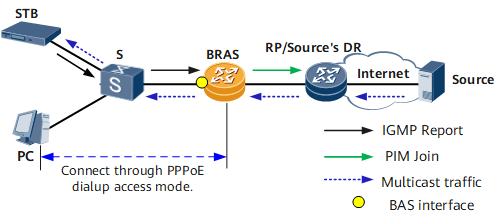User-side Multicast for PPPoE Access Users
Service Description
Because conventional multicast does not provide a method to identify users, carriers cannot effectively manage multicast users who access services such as Internet Protocol television (IPTV). Such users can join multicast groups, without notification, by sending Internet Group Management Protocol (IGMP) Report messages.
To identify these users and allow for improved management of them, Huawei provides the user-side multicast feature.
Networking Description
In Figure 1, a set top box (STB) user initiates a dial-up connection through Point-to-Point Protocol over Ethernet (PPPoE) to the broadband remote access server (BRAS). The BRAS then assigns an IPv4 address to the user for Internet access. To join a multicast program, the user sends an IGMP Report message to the BRAS, and the BRAS creates a multicast forwarding entry for the user. In this entry, the downstream interface is the interface that connects to the user. After the entry is created, the BRAS sends a Protocol Independent Multicast (PIM) Join message to the network-side rendezvous point (RP) or the source's designated router (DR). Upon receipt of this message, the RP or source's DR sends to the BRAS the multicast traffic of the program that the user wants to join. The BRAS then replicates and sends the multicast traffic to the user based on the multicast forwarding entry.
Feature Deployment
Deployment for the user-side multicast feature is as follows:
Configure an IPv4 address pool on the BRAS to assign IPv4 addresses to online users.
Configure Authentication, Authorization and Accounting (AAA) schemes.
Configure a domain for user management, such as AAA.
Configure the PPPoE access mode on the BRAS.
Configure a virtual template (VT) interface.
Bind a VT to an interface.
Bind the sub-interface to the virtual local area network (VLAN) if users are connected to the sub-interface. (For users connected to the main interface, skip this step.)
Configure a broadband access server (BAS) interface and specify a user access type for the interface. (The BAS interface can be a main interface, a common sub-interface, or a QinQ sub-interface.)
Configure basic multicast functions on the BRAS and on the RP or source's DR.
Enable multicast routing.
Enable Protocol Independent Multicast-Sparse Mode (PIM-SM) on BRAS interfaces and on the RP or source's DR interfaces.
Enable IGMP on the BRAS interface connected to users.
- Configure a multicast replication mode on a BAS interface. By default, multicast replication by interface is configured. You can choose to configure one of the following multicast replication modes:
- Session-based multicast replication
- Multicast replication by interface + VLAN
- Multicast replication by VLAN
